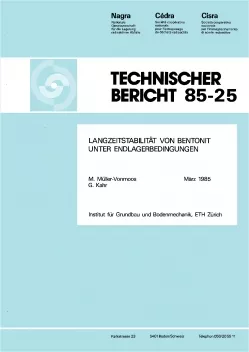
Technischer Bericht NTB 85-25
Langzeitstabilität von Betonit unter Endlagerbedingungen
In order to assess the long-term stability of bentonite under repository conditions, five metabentonite samples from Kinnekulle (Sweden) and one sample of illite from the Massif Central (France) have been studied. It could be shown that the layer surface charge of montmorillonite increased only by a relatively small amount in the course of the transformation into metabentonite; furthermore the final product was not illite, but smectite/illite mixed-layers. The potassium content of the sample expressed as a fraction of the total ion exchange capacity decreased from 72 % at the edge of the 180 cm wide bed of metabentonite to 54 % in the centre, i.e. potassium had not fully exchanged even after 450 million years. From the cation exchange capacity of the mixed layers and from the X-ray and thermoanalytical investigations by means of mass spectrometry, it can be concluded that the proportion of closed layers increases on going from the centre to the edge of the bed, particularly in the outer 10 cm. The innercrystalline swelling capability was essentially maintained, as shown by tests on a sample consisting of a mixture of all samples investigated. It may be assumed that the influence of temperature will be less in the repository than during the formation of the Kinnekulle bed. Conservative calculations show that the transformation of the bentonite into the potassium form will take more than 106 years. The results of the investigations carried out show that this transformation will probably be considerably slower.
